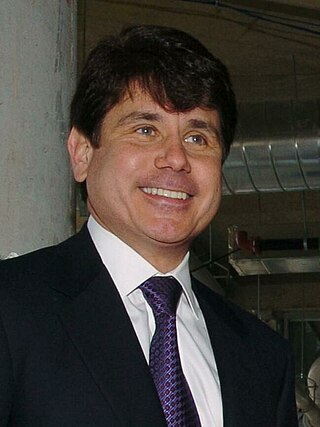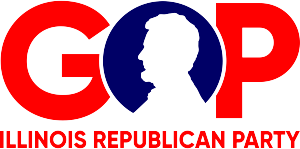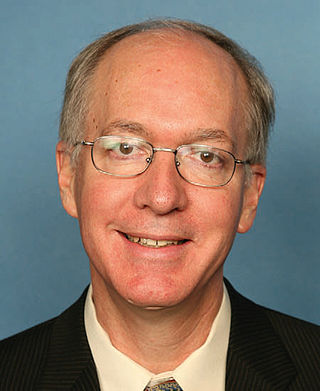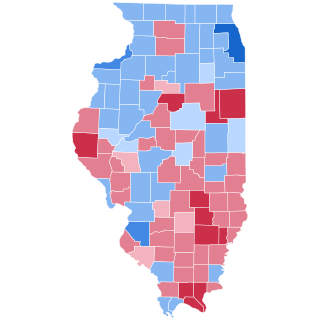Related Research Articles

Rod Blagojevich, often referred to by his nickname "Blago", is an American politician, political commentator, and convicted felon who served as the 40th governor of Illinois from 2003 to 2009. He was impeached, removed from office, convicted, and incarcerated for eight years on federal charges of public corruption. A member of the Democratic Party, Blagojevich previously worked in both the state and federal legislatures. He served as an Illinois state representative from 1993 to 1997, and the U.S. representative from Illinois's 5th district from 1997 to 2003.
Politics of New York have evolved over time. The Democratic Party dominates politics in the state, with the Democrats representing a plurality of voters in New York State, constituting over twice as many registered voters as any other political party affiliation or lack thereof. It is considered one of the "Big Three" Democratic strongholds along with California and Illinois. Historically, New York was a swing state, as from its inaugural election in 1792 until the 1984 election, the state voted for the winning candidate all but seven times. It voted for the winning candidate 86% of the time; however, since 1988, the state has voted Democratic by large margins and frequently provides them over 60% of the vote. Democrats have also controlled the Assembly since 1971 and the Senate since 2019. New York currently has two Democratic United States senators. New York's Class I Senate seat has been Democratic since 1959 and New York's Class III Senate seat has been Democratic since 1999. In addition, New York's House congressional delegation has had a Democratic majority since 1965.

The 2004 United States presidential election in Illinois took place on November 2, 2004, and was part of the 2004 United States presidential election. Voters chose 21 representatives, or electors to the Electoral College, who voted for president and vice president.

The 2006 Illinois gubernatorial election took place on November 7, 2006. Incumbent Democratic Governor Rod Blagojevich won re-election to a second four-year term scheduled to have ended on January 10, 2011. However, Blagojevich did not complete his term, as he was impeached and removed from office in 2009. This was the first election since 1964 that a Democrat was re-elected governor.
New Jersey is one of the fifty U.S. states. The state is considered a stronghold of the Democratic Party and has supported the Democratic candidate in every presidential election since 1992. Democrats have also controlled both chambers of the state legislature since 2004. New Jersey currently has two Democratic United States senators. New Jersey's Class I Senate seat has been Democratic since 1959. New Jersey's Class II Senate seat has been Democratic since 1979. In addition, New Jersey's House congressional delegation has had a Democratic majority since 1965, except for a period between 1995-1999 and 2013-2017. As of July 1, 2020, there were more registered Democrats than unaffiliated voters for the first time in history, as there are more Democrats than Republicans as well.

The politics of Louisiana involve political parties, laws and the state constitution, and the many other groups that influence the governance of the state. The state was a one-party Deep South state dominated by the Democratic Party from the end of Reconstruction to the 1960s, forming the backbone of the "Solid South." This was due to the near-total disenfranchisement of the state's large African-American population during this time, who mostly voted Republican. The Civil Rights era turned the state into a competitive one on the federal level, as it voted for the nationwide winner in every election between 1972 and 2004. It remained Democratic on the state and local level until the turn of the 21st century, allowing Republicans to win control of the state legislature and every statewide office in 2011. Republicans won a United States Senate seat for Louisiana in the election of 2004, for the first time since 1876. Republicans captured both seats in the election of 2014 for the first time since 1872. In the election of 2008, the state voted for a losing presidential candidate for the first time since 1968. Democrats won less than 40% of the presidential popular vote in the state in the elections of 2016 and 2020.
Political control of Ohio has oscillated between the two major parties. Republicans outnumber Democrats in Ohio government. The governor, Mike DeWine, is a Republican, as are all other non-judicial statewide elected officials: Lieutenant Governor of Ohio Jon A. Husted, Ohio Attorney General Dave Yost, Ohio State Auditor Keith Faber, Ohio Secretary of State Frank LaRose and Ohio State Treasurer Robert Sprague.

The politics of Oklahoma exists in a framework of a presidential republic modeled after the United States. The governor of Oklahoma is both head of state and head of government, and of a pluriform two-party system. Executive power is exercised by the governor and the government. Legislative power is vested in the governor and the bicameral Oklahoma Legislature. Judicial power is vested in the judiciary of Oklahoma. The political system is laid out in the 1907 Oklahoma Constitution.

The Illinois Republican Party is the affiliate of the Republican Party in the U.S. state of Illinois founded on May 29, 1856. It is run by the Illinois Republican State Central Committee, which consists of 18 members, one representing each of the state's congressional districts. Once the dominant party in Illinois, the state GOP has become a minority party within the last few decades, holding little power in the state. The current chairman is Don Tracy, who has served since 2021.

Pennsylvania has been considered a swing state throughout its entire history as it only voted for the nationwide loser on only 10 occasions. Meaning it has voted for the national winner 83% of the time, as of 2020. Although, it generally supported Republicans between the Civil War and New Deal eras, as it voted Republican in every election between 1860 and 1932, except for 1912, when the Republican vote was split. Even then, the state's strong Republican ties meant that it backed Republican-turned-Progressive Theodore Roosevelt. The state backed a Democrat in 1936 for the first time since 1856. Pennsylvania generally leaned Democratic since the 1990s, as it backed the Democratic presidential candidate in every election since 1992 except in 2016, when it was won by Republican candidate Donald Trump with a plurality.

After the resignation of Republican Party United States Congressman Dennis Hastert from his Illinois's 14th congressional district seat in the United States House of Representatives on November 26, 2007, a special election was held to fill the vacancy for the remainder of the 110th United States Congress.
Illinois is a Democratic stronghold in presidential elections and one of the "Big Three" Democratic strongholds alongside California and New York. It is one of the most Democratic states in the nation with all state executive offices and both state legislative branches held by Democrats. For most of its history, Illinois was widely considered to be a swing state, voting for the winner of all but two presidential elections in the 20th century. Political party strength in Illinois is highly dependent upon Cook County, and the state's reputation as a blue state rests upon the fact that over 40% of its population and political power is concentrated in Chicago, Cook County, and the Chicago metropolitan area. Outside of Chicago, the suburban collar counties continue trending Democratic while downstate Illinois can be considered more conservative with several Democratic leaning regions including Champaign-Urbana, Bloomington-Normal, Rockford, Peoria, the Quad Cities, and suburban St. Louis

Daniel "Dan" Joseph Seals is an American business consultant and a Democratic politician from Illinois. Seals was the Democratic nominee in three campaigns to become U.S. Representative for Illinois's 10th congressional district. In 2006 and 2008, he was defeated by the incumbent Mark Kirk. In his third run, he was defeated by Republican candidate Robert Dold, on November 2, 2010, after Kirk vacated the seat to successfully run for the U.S. Senate.
Indiana has long been considered to be a Republican stronghold and is rated R+11 on the Cook Partisan Voting Index. The current governor of Indiana is Republican Eric Holcomb, and Republicans hold supermajorities in both chambers of the Indiana General Assembly. It has only supported a Democrat for president four times since 1912—in the elections of 1932, 1936, 1964, and 2008. Historically, the state was a swing state, voting for the national winner all but four times from 1816 to 1912, with the exceptions of 1824, 1836, 1848, and 1876.

The 2010 Illinois gubernatorial election took place on November 2, 2010. Incumbent Democratic Governor Pat Quinn was elected to a full term in office, having become governor in 2009 following the impeachment and removal of Governor Rod Blagojevich. Quinn was elected as the Democratic nominee, the Illinois Green Party nominee was attorney and 2006 nominee Rich Whitney, the Republican nominee was State Senator Bill Brady, the Libertarian Party nominee was Lex Green, and Scott Lee Cohen ran as an independent.

The 2008 United States presidential election in Illinois took place on November 4, 2008, and was part of the 2008 United States presidential election. Voters chose 21 representatives, or electors to the Electoral College, who voted for president and vice president.
The Commonwealth of Massachusetts is often categorized politically as progressive and liberal. All of the state’s U.S. representatives and senators are Democrats. Democrats also form the large majority of the state’s legislature, though the state has a history of electing Republican governors. As with most states, the two main political parties are the Democratic Party and the Republican Party.

The 2000 United States presidential election in Illinois took place on November 7, 2000, and was part of the 2000 United States presidential election. Voters chose 22 representatives, or electors to the Electoral College, who voted for president and vice president.

Elections were held in Illinois on Tuesday, November 2, 2010. Primary elections were held on February 2, 2010.

The 2016 United States presidential election in Illinois was held on Tuesday, November 8, 2016, as part of the 2016 United States presidential election in which all 50 states plus the District of Columbia participated. Illinois voters chose electors to represent them in the Electoral College via a popular vote, pitting the Republican Party's nominee, businessman Donald Trump, and running mate Indiana Governor Mike Pence against Democratic Party nominee, former Secretary of State Hillary Clinton, and her running mate Virginia Senator Tim Kaine. Illinois had 20 votes in the Electoral College.
References
- 1 2 "Illinois: The Most Democratic State". NBC Chicago.
- ↑ "Dave Leip's Atlas of U.S. Presidential Elections - Presidential General Election Results Comparison - Illinois". Uselectionatlas.org. Retrieved October 21, 2022.
- ↑ "The Last Time Illinois Was a Battleground State". Chicago Magazine. Retrieved 2021-03-03.
- ↑ "Dem's Downstate losses offset in Collar Counties" . Retrieved 12 February 2017.
- ↑ "Illinois has highest number of registered voters since 1970". chicagotribune.com. Retrieved 12 February 2017.